There are still many amongst the trade and even consumers who still think that you can judge the cut of a round brilliant cut diamond by its table and depth. The more educated may also look at the crown and pavilion angles as well as the table. However, there are 24 facets on the pavilion of round brilliant cuts that play an important role in what the face up appearance of a round brilliant will look like.
On the pavilion, which is the lower side of a round brilliant cut, there are 24 facets. These can be broken down into two types – the pavilion mains (8 of them) and the lower girdle facets (16 of them), as shown below.
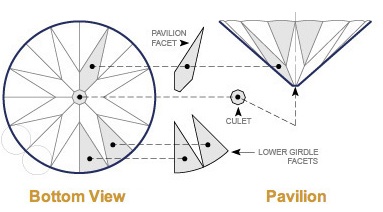
These facets, whilst not usually talked about, control how much contrast (the black arrows) that a round brilliant cut has. The GIA and AGS measure this in terms of a ratio. This ratio is measured by calculating how long the lower girdle facets are compared to how long the length of the pavilion is. Put simply, the shorter the lower girdle facets are, the wider the pavilion mains are, and therefore wider “arrows” from the top. Conversely, the longer the lower girdle facets are, the narrower the pavilion mains are, and therefore shorter “arrows” from the top.
That said, what is the best lower girdle ratio? At the end of the day, the lower girdle ratio all boils down to personal preference.
Using the GIA scale, lower girdle ratios that I’ve seen range from 70 to 85 percent, with 80% being the most common, followed by 75%, with 70% and 85% being very rare. Below are ASET images of there ratios:
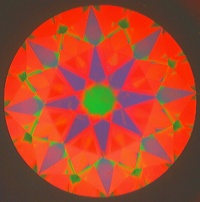
70 percent lower girdle facet ratio
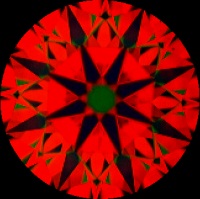
75 percent lower girdle facet ratio
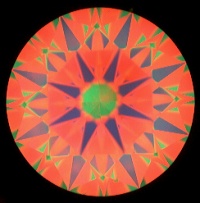
80 percent lower girdle facet ratio
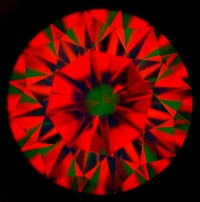
85 percent lower girdle facet ratio
On each of the ASET pictures, note the width and definition of the blue arrows.
My personal preference are for shorter lower girdle facets, lower than 80%, for the following reasons:
- The arrows are more defined, giving in my opinion, a nicer look.
- Bigger black arrows can sometimes hide black inclusions. 🙂
- When you remove head obstruction, the arrows produce the most intense light.
In conclusion, whilst the crown and pavilion angles may control light return, the table control scintillation, the lower girdle facet ratio defines the contrast of a round brilliant diamond, which with white light, controls the brilliance of a diamond.
January 18th, 2011 at 6:00 am
It seems too advanced and very broad for me to comprehend.